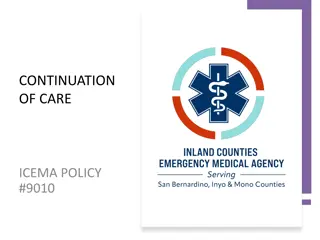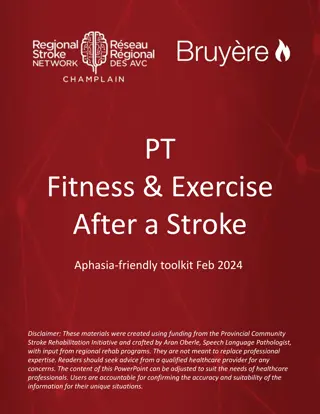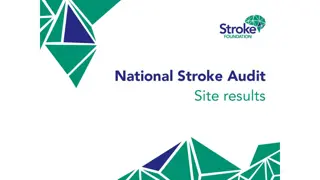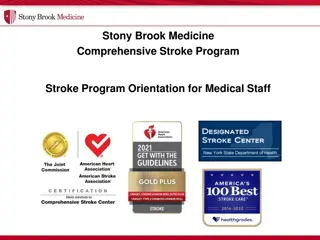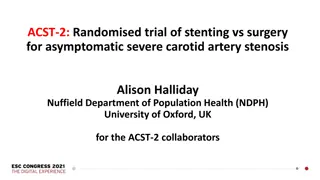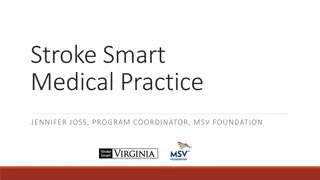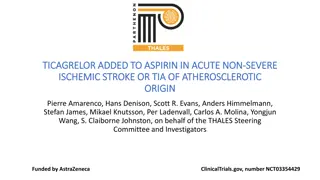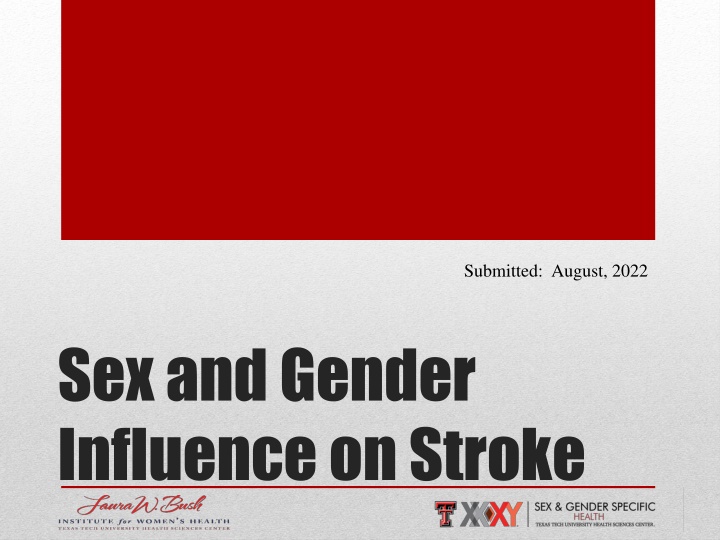
Influence of Sex and Gender on Stroke: Insights and Implications
Explore the impact of sex and gender on stroke incidence, outcomes, and mortality. Discover how differences in biological and social constructs play a role in stroke vulnerability and recovery. Understand the epidemiology, effects, and mortality rates associated with stroke, highlighting the need for tailored interventions and awareness campaigns to address disparities.
Download Presentation

Please find below an Image/Link to download the presentation.
The content on the website is provided AS IS for your information and personal use only. It may not be sold, licensed, or shared on other websites without obtaining consent from the author. If you encounter any issues during the download, it is possible that the publisher has removed the file from their server.
You are allowed to download the files provided on this website for personal or commercial use, subject to the condition that they are used lawfully. All files are the property of their respective owners.
The content on the website is provided AS IS for your information and personal use only. It may not be sold, licensed, or shared on other websites without obtaining consent from the author.
E N D
Presentation Transcript
Submitted: August, 2022 Sex and Gender Influence on Stroke
Introduction Sex and Gender Influence on Stroke
Definitions of Sex and Gender As defined by the National Academies of Medicine in the 2001 paper, Does sex matter? 1 Gender: Socially constructed and enacted roles and behaviors Man/Woman/Other Masculine/Feminine Gender Non-Conforming Sex: Biological male/female/intersex XY or XX chromosomes Sex organs Hormones Introduction
Definitions of Sex and Gender in Research Studies Differences in human population studies are considered gender differences unless the root cause can be positively identified as being attributed to sex steroids or chromosomes1 Differences in males and females in animal studiesare considered sex differences1 Introduction
Overview Sex and Gender Influence on Stroke
Sex Differences in Stroke Sex Differences:1,2 3rd leading factor of death for women.1,2 5th leading factor of death for men.1,2 #1 cause of disability for both sexes.1 Overall, stroke incidence is higher in reproductive age groups in women.3 Age-adjusted incidence of stroke is higher in men vs. women, except in the elderly.1 Overview
Effects of Stroke Stroke Victims Suffer From:1 Neurologic disability Mood disorders Increased likelihood of re-hospitalization and complications Financial burden: $75 billion annually in the US. Cognitive impairment Overview
Epidemiology Sex and Gender Influence on Stroke
Stroke Mortality In 2019, stroke was the 2nd leading cause of death worldwide and the 2nd cause of disability-adjusted life- years.1, 2 Of all stroke deaths in the United States in 2019, 57.1% were women.3 6.2% of all female deaths 4.4% of all men deaths Each year, 55,000 more women than men have a fatal stroke.4 Epidemiology
Stroke Incidence For a 55-year-old individual, lifetime risk of stroke is higher in women (20% 21%) than in men (14% 17%).1 First manifestation of cardiovascular disease:2 Stroke in women Coronary heart disease in men On average, the age at onset of stroke in women is 4 to 6 years older than men.3 Women are more likely than men to be widowed, unmarried, or living alone and have a higher degree of disability in their activities of daily living at the time of their stroke.1 Epidemiology
Prevalence in Types of Stroke Intracranial Aneurysms:1,2 Women > Men Subarachnoid Hemorrhage:1,2 Women > Men Hemorrhagic Stroke:1,2 Men > Women Ischemic Stroke and Transient Ischemic Attack (TIA):3 Women > Men for < 30 years old Men > Women for midlife and for 80 years old Women > Men for > 85 years old Epidemiology
Incidence, Prevalence, and Mortality of Stroke Diseases and risk factors Both sexes Men Women Stroke Prevalence, 2015 2018 7.6 M (2.7%) New and recurrent strokes Mortality, 2018 3.5 M (2.6%) 370.0 K (46.5%) 62 844 (42.5%) 4.1 M (2.8%) 425.0 K (53.5%) 84 966 (57.5%) 795.0 K 147 810 Age 20 years. All ages. Epidemiology
Risk Factors Sex and Gender Influence on Stroke
Modifiable Risk Factors The lifetime risk of stroke is greater in women, with a 1 in 4 risk for women after age 25.1 Key Modifiable Risk Factors:2 Diabetes Hypertension Other Risk Factors:2 Elevated body mass index Atrial fibrillation Lipid profile Smoking Lifestyle Risk Factors
Sex Differences and Risk Factors Type 1 diabetes is more strongly associated with incident ischemic stroke in women compared to men.1 Ischemic stroke risk is greater in women than men at lower fasting blood glucose levels.1 Hypertension and risk of incident total and ischemic stroke is greater in women than men.1,2,3 Risk Factors
Sex Differences and Risk Factors Risk of stroke and all-cause mortality is greater in women with atrial fibrillation than men.1 Female sex has been incorporated as a risk factor in the CHADS2VASc2 score for decision-making about anticoagulation.1,2 High risk of subsequent stroke events is greater in women over 65 years of age with atrial fibrillation.1,2 Risk Factors
Sex Differences and Risk Factors Image Source: Rexrode et al. 2022 Risk Factors
Female-Specific Risk Factors Use of contraceptive pills: Odds Ratio: 2.47.1 Use of low-dose transdermal estrogen formulations may effectively treat menopausal symptoms without increasing stroke risk.2 Adverse pregnancy outcomes, including preterm delivery, gestational hypertension, preeclampsia, and fetal growth restriction increase long-term risk of cardiovascular disease, including stroke, in the mother.2,3 Premature (<40 years old) or early (40 44 years) menopause.2 Risk Factors
Transgender Risk Factors Of 4,960 transgender women matched with 96,000 cisgender men and women:1 Transgender women had an elevated stroke risk compared with cis-women (hazard ratio, 1.9 [95% CI, 1.3 2.6]) Greater increase in risk among transwomen who initiated estrogen treatment For those using hormones, risk appeared to be the greatest after 6 years of follow-up (hazard ratio, 4.1 [95% CI, 1.5 11.4]) compared with cisgender women. Ischemic stroke risk for transgender men did not appear to be increased when compared with cisgender men or women. Risk Factors
Maternal Stroke Sex and Gender Influence on Stroke
Maternal Stroke Incidence 8.2% of U.S. maternal deaths yearly are due to:1 Stroke (including ischemic stroke) Subarachnoid Hemorrhage Intracerebral brain hemorrhage (ICH) Although maternal stroke is rare (30/100000), the incidence of maternal stroke has increased over the last 30 years.2,3 Preeclampsia patients are at higher risk of stroke (in up to 1 in 500 pregnancies).4 Maternal Stroke
Mechanism and Pathophysiology Up to half of maternal strokes are due to subarachnoid hemorrhage or ICH.1 Common stroke mechanisms seen in pregnant and postpartum patients include:2,3,4 cardioembolism carotid vertebral artery dissection, infarction hemorrhage due to cerebral venous sinus cortical vein thrombosis reversible cerebral vasoconstriction syndrome causing vasospasm-related ischemia convexity subarachnoid hemorrhage hypertensive ICH rupture of vascular anomalies intracranial aneurysms, arteriovenous malformations, or moyamoya vasculopathy Maternal Stroke
Mechanism & Pathophysiology Hypertensive disorders of pregnancy contributes to an increased risk of all of these acute cerebrovascular disorders.1 Maternal Stroke
Diagnosis Sex and Gender Influence on Stroke
Stroke Symptoms and Presentation Typical Stroke Symptoms Sudden Onset of:1 Numbness or weakness, especially on one side of the body Confusion or trouble speaking or understanding speech Trouble seeing in one or both eyes Trouble walking, dizziness, or loos of balance or coordination Severe headache with no known cause These symptoms can occur in both women and men; however, women often present with non-localizing symptoms.2 Men have 25% lower odds of misdiagnosis than women.2 Diagnosis
Atypical Stroke Symptoms in Women Non-Localizing Stroke Symptoms in Women:1 Altered Mental Status Hemibody Pain Fatigue Lightheadedness Headache Disorientation Chest Pain Palpitations Loss of Consciousness Diagnosis
Sex-Specific Considerations Known sex-specific vascular risk factors, such as hypertensive disorders of pregnancy and premature menopause, should be considered during diagnosis.1 Sex differences in comorbid conditions may also influence the clinical diagnosis.1 Women were more likely than men to report a history of:1 migraine (33% women/17% men) recent stressors (19% women/12% men) Diagnosis
Stroke Mimics Patients without a cerebrovascular cause for their symptoms are considered to have a stroke mimic. More women than men are initially diagnosed as stroke mimic.1 In patients with 90-day stroke, women with no MRI evidence of a cerebrovascular event were more likely than men to be incompletely investigated.1 A study by Merino et al. found that 1/3 of patients seen by a stroke team over 10 years did not have a stroke but a stroke mimic.2 In this study, the proportion of patients with a stroke mimic was higher among women than men.2 Diagnosis
Treatment Sex and Gender Influence on Stroke
Ischemic Stroke Carotid endarterectomy (CEA) is recommended in symptomatic patients with 50% stenosis and in asymptomatic patients with 60% stenosis.1 Carotid artery stenting can be considered for symptomatic patients with stenosis of 50% at high risk for carotid endarterectomy for anatomic or medical reasons or for patients <70 years old with symptomatic 50% carotid stenosis.1 No evidence was found that the benefit of CEA varied significantly between men and women.1 Treatment
Ischemic Stroke Women have a 13% lower odds of receiving IV r-tPA treatment compared with men.1 Treatment differences in IV r-tPA use may cause large numbers of untreated women.1 This could result in significant consequences for women since women have worse stroke outcomes than men but receive comparable treatment benefits.1,2 AHA guidelines suggest that B vitamins should be used to prevent stroke, both in primary and secondary stroke prevention.3 Treatment
Ischemic Stroke Women may receive endovascular thrombectomy.1 There are no sex differences in efficacy and safety; however, women may gain more optimal life-years after this procedure.1 More research (controlling key variables) is needed that incorporates eligibility criteria. Treatment
Intracerebral Hemorrhage No medical treatments have been definitively proven to improve outcomes for ICH.1 Interventions showed no sex differences in the primary outcome of death or major disability.1 37% of women were significantly older, had higher stroke severity, and had smaller hematoma volumes compared with men.2 There was no effect of sex on the combined end point of death or major disability, hematoma growth, or effect of randomized blood pressure lowering treatment.2 Treatment
Intracerebral Hemorrhage Nearly 20% of all ICH cases are associated with anticoagulant use.1 Discontinuing the offending agent and reversing anticoagulation is key to improving outcomes.1 Sex differences in ICH treatment effects have been less often reported compared with ischemic stroke.2 Disaggregating results by sex, especially in interventional trials, is vital for generalizability of results to both sexes.2 Treatment
Summary Image Source: Rexrode et al. 2022 Treatment


